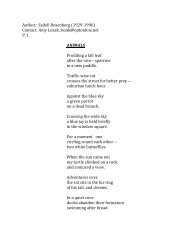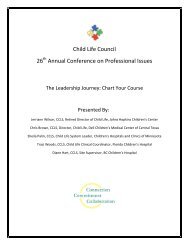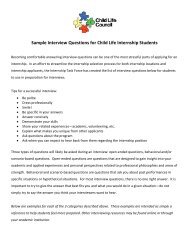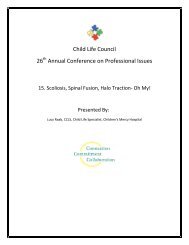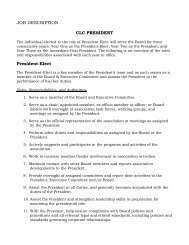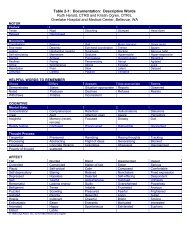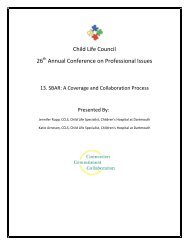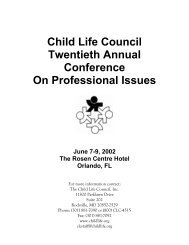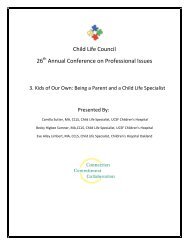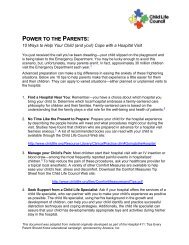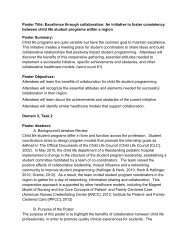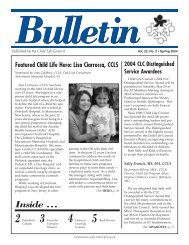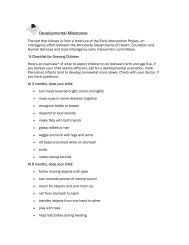Child Life Clinical Internship Curriculum - Child Life Council
Child Life Clinical Internship Curriculum - Child Life Council
Child Life Clinical Internship Curriculum - Child Life Council
Create successful ePaper yourself
Turn your PDF publications into a flip-book with our unique Google optimized e-Paper software.
experience, and incorporate each child’s strengths and interests into the<br />
preparation activities of the care plan.<br />
3. Inventory available preparation materials in current clinical area (child life<br />
department, inpatient units, clinics, ED, OR, etc).<br />
4. Demonstrate effective utilization of play within preparation activities with toddler,<br />
preschooler and school‐ager.<br />
5. Demonstrate creativity in developing specific individualized preparation materials<br />
or activities as required.<br />
6. Demonstrate effective communication skills with children and families.<br />
7. Identify preparation needs in relation to case, treatment and/or intervention plan<br />
and prepare children and families for procedures as strategized, including<br />
adjustments to the plan in response to the child’s immediate needs.<br />
8. Evaluate effectiveness of preparation activities, and make changes to her/his own<br />
learning plan as needed.<br />
9. Complete documentation as required by the organization.<br />
10. Engage in reflective activities such as journal entries or other activities as required.<br />
11. Demonstrate incorporation of cultural sensitivity and relevance into preparation<br />
activities through one individualized care plan reviewed with CCLS.<br />
Required Readings<br />
Goldberger, J., Mohl, A. L. & Thompson, R. H. (2009) Psychological preparation and coping. In<br />
R.H. Thompson (Ed.), The Handbook of <strong>Child</strong> <strong>Life</strong>: A Guide for Psychosocial Care (pp.<br />
160‐198). Springfield, Ill: Charles C. Thomas. (Chapter 9, pp. 160‐198)<br />
Preparing children and families for health care experiences. In L. Gaynard, J. Wolfer, J.<br />
Goldberger, R. Thompson, L. Redburn , & L. Laidley (Eds., 1998), Psychosocial Care of<br />
<strong>Child</strong>ren in Hospitals: A <strong>Clinical</strong> Practice Manual from the ACCH <strong>Child</strong> <strong>Life</strong> Research<br />
Project (pp. 93‐110). Rockville, MD: <strong>Child</strong> <strong>Life</strong> <strong>Council</strong>. (Chapter 9, pp. 93‐110)<br />
Koller, D. (2008). Preparing children and adolescents for medical procedures. Evidence‐Based<br />
Practice Statement from the <strong>Child</strong> <strong>Life</strong> <strong>Council</strong>. Retrieved from:<br />
http://www.childlife.org/files/EBPPreparationStatement‐Complete.pdf<br />
Accessed March 27, 2011<br />
Klinzing, D.G. & Klinzing, D. (2009). Communication in child life. In R.H. Thompson (Ed.), The<br />
Handbook of <strong>Child</strong> <strong>Life</strong>: A Guide for Psychosocial Care. Springfield, Ill: Charles C.<br />
Thomas.<br />
47



